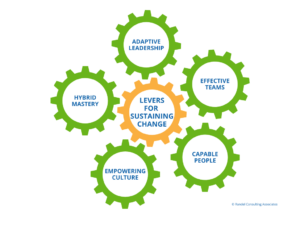How do you create and sustain change? What enables all the constituent elements of change to stay connected with one another, interacting in ways that maintain and sustain forward momentum?
“It’s working like a well-oiled machine” is a compliment. And it’s a compliment because it recognizes that this is not a given and cannot be assumed.
A car engine has many intricate inner components. Alone, they are useless. But together, they enable the engine to do its job of driving the car forward.
 These components are interconnected, a state in which they can influence one another in both positive and negative ways. They work in a planned way to keep the engine running smoothly. A problem in one element can affect the overall operations, potentially preventing the car from reaching its destination.
These components are interconnected, a state in which they can influence one another in both positive and negative ways. They work in a planned way to keep the engine running smoothly. A problem in one element can affect the overall operations, potentially preventing the car from reaching its destination.
This delicate balance forms the basis for our journey through the RCA Levers for Sustaining Change, our framework that identifies five interconnected elements that drive the creation and sustainability of change in organizations.
#1. Effective Teams
Here’s a fundamental truth… Effective teams are at the heart of successful, sustained change.
Think about the grandeur of the Oscars, where stars take the stage to accept their awards. Have you ever heard someone say, “I did this all by myself“? Of course not! They always extend their gratitude to the teams that supported and collaborated with them. This practice isn’t exclusive to Hollywood; it extends to organizations worldwide.
An iconic figure like Steve Jobs is often given the credit for Apple’s success. But behind the scenes, there was a talented team, including the likes of Steve Wozniak and countless others, who contributed to turning their vision into reality.
Now, let’s flip the coin. We’ve all encountered ineffective teams at some point in our professional journeys. They can be a real challenge to work with, causing frustration, demotivation, and pain. These teams often display common dysfunctions:
- Low Trust: Team members hesitate to share their thoughts, fearing judgment or hidden agendas.
- Destructive Conflict: Instead of constructive debates, team members engage in destructive arguments, often personalized.
- Low Commitment: Decisions made in meetings lack genuine commitment, leading to poor follow-through.
- Accountability Issues: Accountability becomes the team leader’s burden, as team members fail to hold each other accountable.
These issues are drawn from Patrick Lencioni’s “Five Dysfunctions of a Team“ model, which serves as a guide for understanding and improving team dynamics.
So, what exactly defines a team? The book – “Wisdom Of Teams” (Smith and Katzenbach, 2015) – defines a team as a small group of people with complementary skills, committed to a common purpose and performance goals, and an approach for which they hold themselves mutually accountable.
However, real-world teams often fall short in several areas, such as size, skill mismatches, a lack of shared purpose, or insufficient accountability.
Effective teams, therefore, play a critical role in instigating change – as well as in sustaining change. They are the catalysts for progress, whether you’re navigating the seasons of change, implementing a new strategy, or preparing for a transformation. And they are the pillars that support the adoption and mainstreaming of the change, providing a space in which individual members can build the new habits of behavior needed to sustain change.
What makes an effective team, according to Patrick Lencioni’s model? It’s a team where…
- Trust is the foundation, where members trust one another implicitly. Honesty and transparency prevail, fostering open and unfiltered communication.
- Conflict is healthy and centered around ideas, not personal attacks.
- Commitment runs deep, with team members dedicated to decisions made collectively.
- Accountability is shared among all team members, underpinned by mutual trust.
- Together, they achieve collective Results, working towards a common goal.
In a nutshell, effective teams are both “smart” and “healthy.” They possess the intelligence to problem-solve and innovate, but their commitment to healthy behaviors enables them to sustain success.
To illustrate this point further, let me share a story. This comes from my own experience working with a small consulting company that had a dozen employees. They faced the challenge of integrating newly hired team members who were struggling to adapt to the high level of productivity and performance. These newer members exhibited ineffective behaviors – lack of accountability, low productivity, and more.
Through a comprehensive approach involving team assessments, in-person retreats, and leadership coaching, we supported the leaders as they transformed this team. Focusing on trust-building, open dialogue, healthy conflict resolution, and common goals, they developed into a highly effective and harmonious unit. Their outstanding work, especially during the challenging times of the pandemic, exemplified the power of an effective team.
In closing, the importance of effective teams cannot be overstated. They are the foundational lever for driving change and ensuring sustainable growth. In our upcoming newsletters and blog posts, we’ll delve deeper into practical tools and strategies for nurturing and harnessing the power of effective teams.
What are you doing to enable effective teams in your organization?
Drop me a line, and let me know!
Until next time,
Learn more about the other levers: Capable People, Empowering Culture, Hybrid Mastery and Adaptive Leadership



